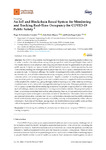An IoT and Blockchain Based System for Monitoring and Tracking Real-Time Occupancy for COVID-19 Public Safety

Use este enlace para citar
http://hdl.handle.net/2183/37338Coleccións
- Investigación (FIC) [1685]
Metadatos
Mostrar o rexistro completo do ítemTítulo
An IoT and Blockchain Based System for Monitoring and Tracking Real-Time Occupancy for COVID-19 Public SafetyData
2020-11-14Cita bibliográfica
Fernández-Caramés, Tiago M., Iván Froiz-Míguez, and Paula Fraga-Lamas. 2020. "An IoT and Blockchain Based System for Monitoring and Tracking Real-Time Occupancy for COVID-19 Public Safety" Engineering Proceedings 2, no. 1: 67. https://doi.org/10.3390/ecsa-7-08207
Resumo
[Abstract]: The COVID-19 pandemic has brought several limitations regarding physical distancing in order to reduce the interactions among large groups that could have prolonged close contact. For health reasons, such physical distancing requirements should be guaranteed in private and public spaces. In Spain, occupancy is restricted by law but, in practice, certain spaces may become overcrowded, existing law infringements in places that rely on occupancy estimations that are not accurate enough. For instance, although the number of passengers who enter a public transportation service is known, it is difficult to determine the actual occupancy of such a vehicle, since it is commonly unknown when and where passengers descend. Despite a number of counting systems existing, they are either prone to counting errors in overcrowded scenarios or require the active involvement of the people to be counted (e.g., going through a lathe or tapping a card when entering or exiting a monitored area) or of a person who manages the entering/exit process. This paper presents a novel IoT occupancy system that allows estimating in real time the people occupancy level of public spaces such as buildings, classrooms, businesses or moving transportation vehicles. The proposed system is based on autonomous wireless devices that, after powering them on, do not need active actions from the passengers/users and require a minimum amount of infrastructure. The system does not collect any personal information to ensure user privacy and includes a decentralized traceability subsystem based on blockchain, which guarantees the availability, security and immutability of the collected information. Such data will be shared among smart city stakeholders to ensure public safety and then deliver transparent decision-making based on data-driven analysis and planning.
Palabras chave
IoT
Tracking
Traceability
Blockchain
Smart cities
Smart campus
COVID-19
Contact tracing
Occupancy
Tracking
Traceability
Blockchain
Smart cities
Smart campus
COVID-19
Contact tracing
Occupancy
Descrición
The conference was held online, 15-30 November 2020.
Versión do editor
Dereitos
Atribución 3.0 España
ISSN
2673-4591






